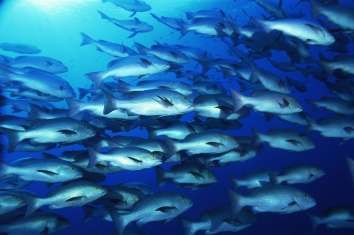Researchers identify nature of fish's 'sixth sense'

A team of scientists has identified how a "sixth sense" in fish allows them to detect flows of water, which helps resolve a long-standing mystery about how these aquatic creatures respond to their environment. Their findings, which appear in the journal Physical Review Letters, illustrate how sensory systems evolve in accordance with physical principles while also offering a framework for understanding how sensory networks are structured.
"We identified a unique layout of flow sensors on the surface of fish that is nearly universal across species, and our research asks why this is so," explains Leif Ristroph, an assistant professor at New York University's Courant Institute of Mathematical Sciences and one of the study's authors. "The network of these sensors is like a 'hydrodynamic antenna' that allows them to retrieve signals about the flow of water and use this information in different behaviors."
The study's other authors were James Liao, an assistant professor at the University of Florida's Whitney Laboratory for Marine Bioscience, and Jun Zhang, a professor of physics and mathematics at NYU and NYU Shanghai.
It is well known that fish respond to changes in their fluid environment. These include avoiding obstacles, reducing swimming effort by slaloming between vortices, or whirlpools, and tracking changes in water flow left by prey—even without the aid of vision.
To explore how fish exploit flow information, the research team focused on a fish's "lateral line"—a system of sensory organs known to detect both movement and vibration in the water that surrounds them—with particular consideration to the line's sensory-laden canals that open to the environment through a series of pores. They specifically focused on the placement of these canals along the body, noting that their location can help explain how a fish's sixth sense functions. For instance, the concentration of these canals at the heads of blind cave fish seems well-suited for detecting obstacles.
To test their theory, the researchers created a plastic model of a rainbow trout that replicated the location of the fish's canals and included illuminated markers used to detect the speed of surrounding water.
In their experiments, the model fish was put through a series of tests the replicated real- life aquatic conditions—changes in water flow that altered water pressure or mimicked the presence of "prey"—and examined where the canals were located in relation to strongest changes in water pressure.
Their results showed that, as predicted, the canal system is concentrated at locations on the body wherever strong variations in pressure occur. Just as the shape of a TV or radio antenna is designed to detect electromagnetic signals, the fish's canal system is like an antenna laid out on the body surface and configured to be sensitive to pressure changes. The team's use of finely detailed models – developed with the help of a taxidermist who made custom molds from real trout – made it possible to record this data for the first time.
"You can't put pressure sensors on a live fish and have it behave normally," Liao says. "This was a creative way to use engineering and physics techniques to answer biological questions you can't answer otherwise."
Journal information: Physical Review Letters
Provided by New York University

















